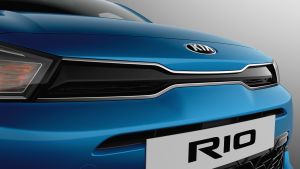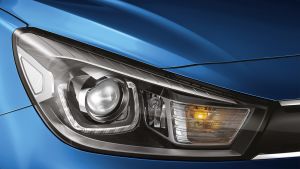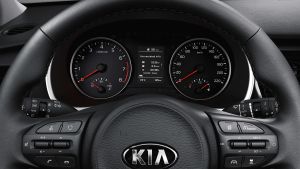A
Auto Express
Guest
This is the updated Kia Rio. It’s available to order now, with prices starting from £13,395 for the entry-level “1” specification. This figure climbs to £20,895 for the range-topping GT-Line S variant, which Kia hopes will offer a suitable range of competitors for everything from the Toyota Yaris to the Volkswagen Polo.
The updated Rio’s design tweaks are minor. There’s a slightly narrower version of the brand’s trademark Tiger Nose radiator grille, a new set of 16-inch alloy wheels and a pair of new paint finishes (Storm Grey and Azure Blue), but that’s about it.
Inside, Kia’s revisions are equally subtle, with a few minor material and trim updates. The most obvious difference is the new eight-inch infotainment system, which gives drivers access to a range of connected services including live traffic information, weather forecasts and parking availability. The system also now offers support for voice commands.
The biggest change over the outgoing Rio is the addition of a new 1.0-litre mild-hybrid petrol engine, which has an output of 118bhp and 200Nm of torque. The powertrain features a belt-driven starter-generator and a compact lithium-ion battery pack, which recovers energy that would be wasted when decelerating and feeds it back into the car’s electrical system.
Kia says that when hitched to its seven-speed dual-clutch automatic gearbox, the new powertrain will provide a 0–62mpg time of 9.9 seconds and a top speed of 118mph. More importantly, it’ll return a claimed 52.3mpg on the WLTP combined cycle, while emitting as little as 123g/km of CO2.

image

image

image

image

image

image

image

image

image

image

image
The new engine can also be mated to Kia’s new “clutch-by-wire” manual gearbox, which we first saw on the facelifted Stonic. The transmission does without the traditional mechanical linkage between the clutch pedal and the master cylinder, swapping it for an electronically controlled system which operates the opening and closing of the clutch.
Kia says this setup reduces CO2 output over a conventional manual gearbox under real-world driving conditions. The car’s ECU can automatically disengage the engine and coast in neutral whenever it senses there’s an efficiency benefit to be had, which Kia says will burn less fuel and create less emissions.
Buyers can also have a non-electrically assisted version of the same 1.0-litre three-cylinder petrol engine, with an output of 99bhp and 172Nm of torque – along with an updated version of the old Rio’s 1.25-litre four-cylinder petrol engine.
Facelifted Kia Rio: trim-levels and equipment
Standard equipment for the entry-level Kia Rio “1” includes electrically operated and heated door mirrors, a heated rear windscreen and hill-hold assist. Inside, there’s air conditioning, a monochrome bluetooth radio system, a four-speaker stereo and cloth upholstery.

image

image

image

image

image

image

image

image

image

image

image
The Rio “2” is priced from £15,595 and adds 15-inch alloy wheels, projector headlamps, LED daytime running lights, front fog lamps and LED indicators set into the door mirrors. The interior features premium cloth upholstery, a leather-trimmed steering wheel and gearstick and rear electric windows.
Buyers get a little more technology, too, with cruise control, a reversing camera, a larger 4.2-inch display for the instrument cluster and a six-speaker stereo – along with the brand’s new eight-inch infotainment screen, which supports both Apple CarPlay and Android Auto.
Kia’s Rio “3” starts at £18,895. It builds on the “2” specification with 16-inch alloy wheels, chrome window trim, rear privacy glass and rain sensing wipers. The interior gets a lift, too, with faux leather upholstery, heated front seats, a heated steering wheel, sat-nav, automatic air conditioning and an auto-dimming rear-view mirror.
Finally, the flagship GT-Line S model adds 17-inch alloy wheels, a unique dark chrome radiator grille, a sports body kit, new LED front fog lamps and a twin-exit exhaust system. The cabin is trimmed in a blend of black cloth and faux leather, and buyers get a new sports steering wheel, faux-carbon fibre dashboard trim and aluminium pedal box.
The GT-Line S model has a starting price of £19,895 and is exclusively available with the Kia’s new mild-hybrid powertrain.
What does the new Kia Rio have to beat? These are the best superminis on sale...
Continue reading...
The updated Rio’s design tweaks are minor. There’s a slightly narrower version of the brand’s trademark Tiger Nose radiator grille, a new set of 16-inch alloy wheels and a pair of new paint finishes (Storm Grey and Azure Blue), but that’s about it.
- SEE MORE Best superminis 2020
Inside, Kia’s revisions are equally subtle, with a few minor material and trim updates. The most obvious difference is the new eight-inch infotainment system, which gives drivers access to a range of connected services including live traffic information, weather forecasts and parking availability. The system also now offers support for voice commands.
The biggest change over the outgoing Rio is the addition of a new 1.0-litre mild-hybrid petrol engine, which has an output of 118bhp and 200Nm of torque. The powertrain features a belt-driven starter-generator and a compact lithium-ion battery pack, which recovers energy that would be wasted when decelerating and feeds it back into the car’s electrical system.
Kia says that when hitched to its seven-speed dual-clutch automatic gearbox, the new powertrain will provide a 0–62mpg time of 9.9 seconds and a top speed of 118mph. More importantly, it’ll return a claimed 52.3mpg on the WLTP combined cycle, while emitting as little as 123g/km of CO2.

image

image

image

image

image

image

image

image

image

image

image
The new engine can also be mated to Kia’s new “clutch-by-wire” manual gearbox, which we first saw on the facelifted Stonic. The transmission does without the traditional mechanical linkage between the clutch pedal and the master cylinder, swapping it for an electronically controlled system which operates the opening and closing of the clutch.
Kia says this setup reduces CO2 output over a conventional manual gearbox under real-world driving conditions. The car’s ECU can automatically disengage the engine and coast in neutral whenever it senses there’s an efficiency benefit to be had, which Kia says will burn less fuel and create less emissions.
Buyers can also have a non-electrically assisted version of the same 1.0-litre three-cylinder petrol engine, with an output of 99bhp and 172Nm of torque – along with an updated version of the old Rio’s 1.25-litre four-cylinder petrol engine.
Facelifted Kia Rio: trim-levels and equipment
Standard equipment for the entry-level Kia Rio “1” includes electrically operated and heated door mirrors, a heated rear windscreen and hill-hold assist. Inside, there’s air conditioning, a monochrome bluetooth radio system, a four-speaker stereo and cloth upholstery.

image

image

image

image

image

image

image

image

image

image

image
The Rio “2” is priced from £15,595 and adds 15-inch alloy wheels, projector headlamps, LED daytime running lights, front fog lamps and LED indicators set into the door mirrors. The interior features premium cloth upholstery, a leather-trimmed steering wheel and gearstick and rear electric windows.
Buyers get a little more technology, too, with cruise control, a reversing camera, a larger 4.2-inch display for the instrument cluster and a six-speaker stereo – along with the brand’s new eight-inch infotainment screen, which supports both Apple CarPlay and Android Auto.
Kia’s Rio “3” starts at £18,895. It builds on the “2” specification with 16-inch alloy wheels, chrome window trim, rear privacy glass and rain sensing wipers. The interior gets a lift, too, with faux leather upholstery, heated front seats, a heated steering wheel, sat-nav, automatic air conditioning and an auto-dimming rear-view mirror.
Finally, the flagship GT-Line S model adds 17-inch alloy wheels, a unique dark chrome radiator grille, a sports body kit, new LED front fog lamps and a twin-exit exhaust system. The cabin is trimmed in a blend of black cloth and faux leather, and buyers get a new sports steering wheel, faux-carbon fibre dashboard trim and aluminium pedal box.
The GT-Line S model has a starting price of £19,895 and is exclusively available with the Kia’s new mild-hybrid powertrain.
What does the new Kia Rio have to beat? These are the best superminis on sale...
Continue reading...
